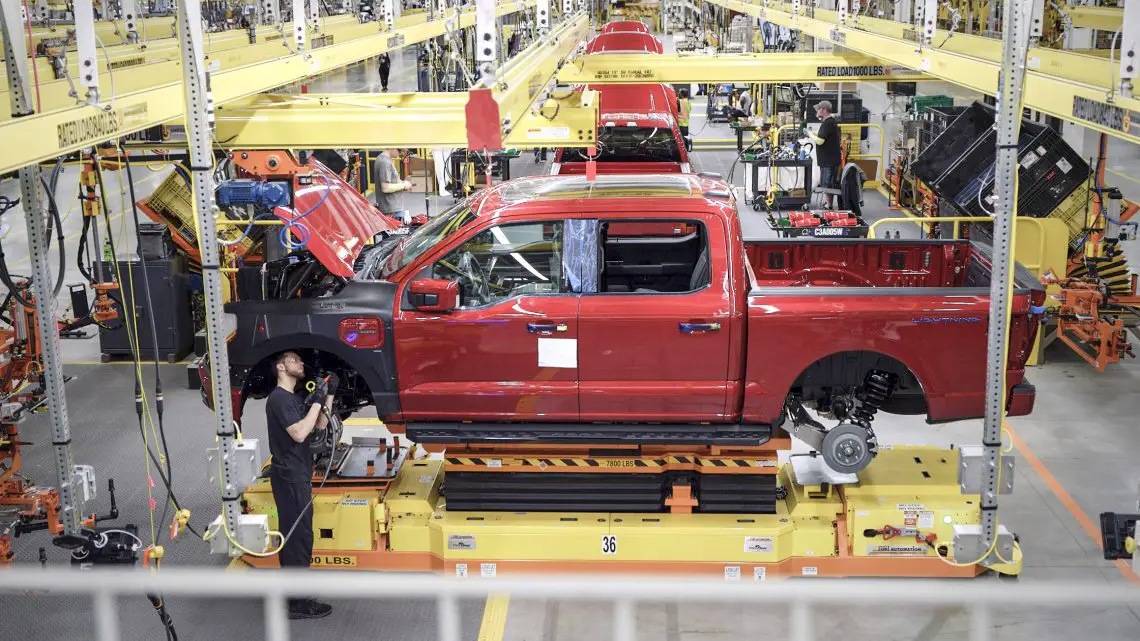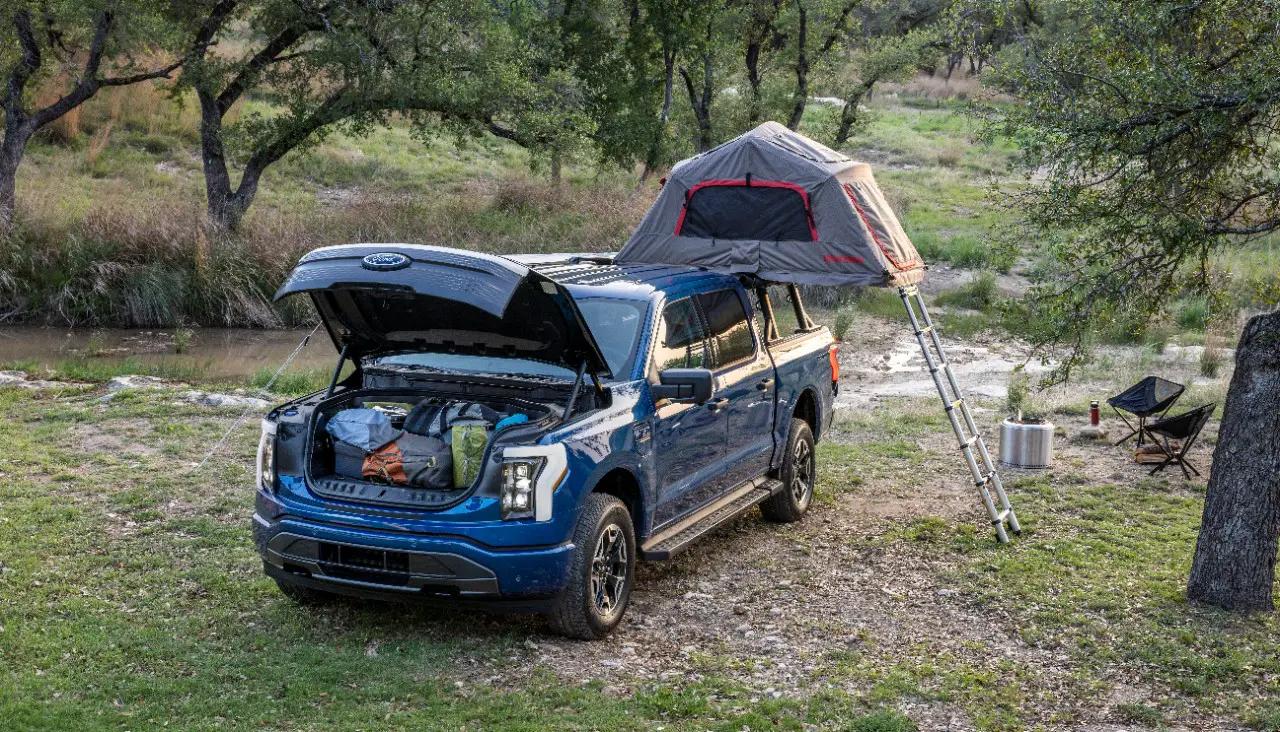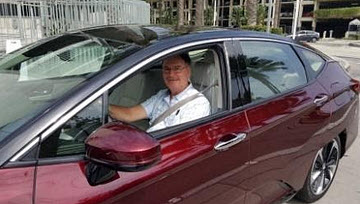
A Ford F150 Lightning Could Travel a Thousand Miles on Hydrogen
June 1, 2021The Ford F150 Lightning looks to be an excellent truck in all but one regard: its range. It’s advertised to be only 300 miles with the extended range package (larger and heavier); it will probably be even less much of the time. Worse, pulling a travel trailer will further reduce the range, making it inept at recreational towing. Let’s fix that by removing the ton of batteries, replacing it with hydrogen gas and a fuel cell.
Reasons to be enthusiastic about the Lightning:
Ford’s battery-powered truck offers some fine features (see Forbes) Wheels including an independent suspension with all-wheel-drive, fold-flat “bed seats”, ten thousand lbs of towing capacity, true self-driving (initially on 100k miles of pre-qualified divided highways), outlets to run multiple power tools or your entire house, and the ability to help back up the grid during peak loads. That’s all great stuff!
But – and it’s a real concern – its stated range appears to be optimistic for several reasons, and is likely to be insufficient for important applications.
One reason: Temperature problems. Tests by AAA of battery-powered vehicles show a 40% range reduction at 20 degrees F with the heater running, and a 17 percent reduction at 95 degrees when using the A/C. The battery-powered Lightning’s true range may be significantly less than 300 miles when the climate’s not cooperating.
Then, there’s the towing problem. Towing prowess is why many of us buy trucks. My 2019 F150 is a towing pro, but its gasoline mileage drops from the low 20’s to around 12 mpg when hauling our mid-size travel trailer – that 50% drop is typical for many rigs. The range of any EV will be similarly reduced – towing requires pulling energy from the battery much more rapidly. The oversized gasoline tank in our 2019 truck gives us 400+ towing miles before refueling, but it’s unlikely that Ford can squeeze much more battery into the Lightning. The battery weight is already nearly twice that of a Tesla’s, and we’d need up to several times the current amount of available energy to get to a decent towing range.
Combine AAA’s temperature-related reductions with the trailering hit, and a Lightning’s range may be much less than advertised, in important situations. Here are Jalopnick’s thoughts on the subject. They are not optimistic.
So: As an around-town truck, especially for contractors who need electricity on the job, the battery-powered Lightning’s going to be great. But, optioned to $60k++ and with that true self-driving feature, it should also be a long-distance cruiser and towing machine. It’s not.
What’s a pickup to do?
Suggestion: Ford should propel the Lightning with hydrogen rather than a ton of batteries. The “LightningH” would still be an EV, but with better range.
How much better? Let’s go figure:

2022 Ford F150 Lightning – Image Credit Ford Press Media Gallery
Proposed hydrogen-fueled LightningH – The modifications:
First, let’s replace the full-size under-bed spare with a pickup-quality compact tire. Unless you plan to travel the far and scraggly peaks, a donut’s fine – it’ll get you to the tire shop. Store the smaller spare in the “front trunk” and there’s still room up there for a sizeable hydrogen storage tank. The “frunk” has 14 cubic feet (https://tinyurl.com/cbcxbrsw), 100 gallons, of volume available. Let’s install a 70 gallon hydrogen storage tank up there, allowing room for that spare tire and a carbon fiber high-pressure tank wrap.
Then – let’s remove the batteries and store hydrogen in their place, in three, 9’ long 12” diameter cylinders. We can fit about 90 gallons of high-pressure tankage there, giving us a total of 160 gallons of hydrogen storage.
A hydrogen-powered electric vehicle uses a fuel cell and control electronics to produce its electricity. It also needs a relatively small (a few kWh) lithium battery to start things up, smooth out power delivery and recapture energy while braking. There’s room for that gadgetry in back, where the full-size spare tire used to hang out.
Now – A helpful data point: The 2021 Hyundai Nexo hydrogen-powered SUV stores 6.3 kg of hydrogen in 41 gallons of tankage. Our 160 gallons will handle 3.9 times that amount, storing more than 24 kg of hydrogen.
How far will that take us? We have a key clue: The Forbes Wheels article estimates the current Lightning’s battery capacity at around 165 kWh. That powers its 300-mile advertised range. We can use that value to estimate our LightningH’s abilities:
A 60%-efficient fuel cell can extract about 24 kWh from a kilogram of hydrogen, so the 24 kg in our LightningH will produce about 580 kWh. That’s 3.5 times the energy available in the current Lightning’s battery — it will provide at least 3.5 times the current range.
Conclusion: We could get more than 1000 miles (3.5 x 300) of “advertised range” in our hydrogen-fueled truck.
Towing will reduce that by perhaps 50% so the truck should tow for ~500 miles. And, we haven’t yet taken credit for replacing 2000 lbs of batteries with a few hundred lbs of hydrogen gadgetry. Lighter is better, so expect even more range improvement.
Should we correct for some of the cold or hot weather issues that decrease range in battery EVs? A test in Switzerland provides an indication: A hydrogen-powered Hyundai Nexo handily outperformed a battery-powered Tesla Model S in the chilly Swiss mountains, confirming that cold shouldn’t reduce hydrogen energy availability. For now, let’s just assume that other LightningH energy losses (from A/C use or cab heating) are countered by replacing that ton of batteries.
Bottom line: The hydrogen-powered truck should have better range than my gasoline-powered F150.
That works for me.
Range problem solved. Our LightningH will be a hydrogen highway cruiser!
Author’s notes:
This is just a quick estimate showing how the F150 Lightning’s range could be improved using hydrogen fuel. The truck looks to be an excellent platform, but it really needs that mileage stretch. Given the assumptions I’ve made here to get to a result, please be aware that “your mileage may vary” when more info arrives.
Also: This scenario assumes that there will be plenty of hydrogen gas stations to refuel our new truck. That’s certainly not true at the moment but recall that we quickly moved from horses to Fords, back when there were no gasoline stations anywhere. Necessity bred stations back then; I think it will again, in the same way that Tesla is of necessity flooding the planet with battery Superchargers. We’ll consider this in future articles, but it’s important to recognize that hydrogen can be generated at the gas station itself using only electricity, water and a gadget called an electrolyzer. Hydrogen can be produced and stored locally whenever the electrical grid’s load is light, or when wind and solar are producing more energy than customers can use (that’s already happening). Hydrogen gas stations will become an integral part of our new, smart grid. They’ll be important energy buffers as we move to a green all-electric world.
 The Author: Dr. H. Robert Meyer, seen here driving a hydrogen-powered demo at a SEPA energy conference, is an environmental scientist with decades of experience. After serving as a Navy Officer, he began his career at the Oak Ridge National Laboratory then moved on to run large projects around the country. His background in physics, environmental protection and alternative energy helps unravel the challenges associated with converting a planet to all-electric. His website at https://poweringaplanet.com is focused on the tough-to-grasp size of the CO2 reduction problem — the effort required to reverse climate change is not yet widely understood. We need to drastically ramp up the installation rates of green energy and its backups to get to zero emissions before time runs out.
The Author: Dr. H. Robert Meyer, seen here driving a hydrogen-powered demo at a SEPA energy conference, is an environmental scientist with decades of experience. After serving as a Navy Officer, he began his career at the Oak Ridge National Laboratory then moved on to run large projects around the country. His background in physics, environmental protection and alternative energy helps unravel the challenges associated with converting a planet to all-electric. His website at https://poweringaplanet.com is focused on the tough-to-grasp size of the CO2 reduction problem — the effort required to reverse climate change is not yet widely understood. We need to drastically ramp up the installation rates of green energy and its backups to get to zero emissions before time runs out.



 With over 15 years of reporting hydrogen news, we are your premier source for the latest updates and insights in hydrogen and renewable energy.
With over 15 years of reporting hydrogen news, we are your premier source for the latest updates and insights in hydrogen and renewable energy.
Hydrogen tanks below a vehicle could be incredibly catastrophic in an accident… However, I wonder if something isn’t already in the works to use fuel cell technology as a range extender. Make it removable and store it in the bed like a tool box and you could rent it, swap it, keep as a home backup when not used, and extend an everyday truck with 300+ miles into a 1,000 mile hauler when needed.
Nathan (thanks very much for your comment) – I don’t like the 10,000 psi tanks much, either, and am hoping that an alternative is found soon. There’s been a lot of research on that for decades, but DOE and DOT ought to put a $billion into this now to get it done. The latest (it’s linked in the Updates post on my website) is interesting – there may be a mechanism down at nanoscale that moves H into etched channels not much larger than the atom. It makes some sense – gas pressure vanishes when an atom is immobilized. I’ll keep an eye on that.
In the meantime, tanks stored between the F150 steel frame members are probably going to be OK – there are now quite a few H-vehicles out there with what’s probably less protection than a truck frame, and I’m not seeing headlines about tank failures. The truck would have good range if only those three cylinders were used, but I added the “frunk tank” to get to the thousand-mile headline, and because all of that volume is available, and because a pickup just doesn’t need a trunk… 🙂 That tank, properly protected and toward the rear of the frunk, ought to be safe as well, given a steel beam or two ahead of it. We’ve had good luck with many millions of vehicle gasoline tanks getting through most accidents plus garage storage; gasoline leaking in a garage is on a par with natural gas leaking in the basement – both are bad news, possibly worse than fast-dissipating hydrogen gas. I suspect good engineering can minimize the 10k psi hazard until we hopefully get to low pressure high-density storage. -Bob Meyer
A front tank can be better protected if Iron materials used is of a Graphene based steel .
If a catastrophic accident happened, escaping Hydrogen vents straight up from fracture point. Gasoline spreads out along the ground. Have you ever used gasoline to start a fire, Yes I know its unsafe. Have watched idiots throw gasoline on a fire, stand downwind and light it a couple seconds later, then run like the devil’s behind them. Splilling gasoline from an accidental puncture is far more dangerous than Hydrogen.
Great comparison of a BEV vs a H2 FCEV, when will the country wake up and embrace an H2 green economy . Thanks for the numbers, just need the infrastructure enabled thru out the entire hydrogen eco system to catch up to lithium.
Tony – Thanks very much for your comment – I’m just writing an article on getting the infrastructure out, and it turns out that 100 H-gas stations, each electrolyzing H from water onsite, would cover the country comfortably for early adopters of a 1000-mile LightningH. I’ll submit it to HFN soon. -Bob Meyer
Right on — but how do you squeeze 24 kgs of 10k psi hydrogen in three 9 foot long 12 inch diameter fuel tanks. Can you provide your calculations?
Thanks very much for your question, Don – I also put a 70-gallon tank in the “Frunk”, for a total of 160 gallons of H storage. 41 gallons in the Hyundai Nexo stores more than 6 kg of H, so 160 gallons gets to the 24 kg.
The “frunktank” is just a well-carbon-fibered, steel-beam-in-front tank with the dimensions to fit. There are 100 gallons available in the frunk, so that seems doable.
The three cylinders are assumed to be 12″ in diameter (that’s the depth I measure under my F150), using 36″ of the 42″ inside-the-frame width. I measured more than 9′ available there front-to-rear. I assumed that 3″ of the 12″ cylinder thickness will be used for the layered tank and carbon fiber wrap, leaving 9″ for the hydrogen. Pi times 4.5″x4.5″x9’x(12″/foot)x3 cylinders gets me 89 gallons (at 231 cubic inches per gallon) under the cab, for the 160 total. The cylinders only, replacing the batteries, would more than double the 300-mile advertised range of the Lightning, but the frunktank takes it to 1000, a very fine number. 🙂
-Bob Meyer
How about contacting Plasma Kinetics from San Jose, CA area that was able to store hydrogen on a disk? You buy several disks for long distance travels. No explosion, less hassle and it is clean hydrogen… SG
Interesting, does it really work?
This was a good “back of the napkin” comparison. It is worth noting that 1 kg of hydrogen is the approximate energy equivalent of 1 gallon of regular gasoline. Average gas fuel mileage is 20 miles vs around 70+ miles for 1 kg of H2. Now if that isn’t convincing enough, note that burning a gallon of gasoline releases ~20 lbs. of CO2 into the atmosphere vs near zero for H2. Plus there is the added bonus of Oxygen release in splitting water to produce hydrogen. Then there is the battery recycling issues. So in general, 3 x the range for hydrogen vs gas energy equivalent.
Michael – Thanks for that parallel range analysis! It’s reassuring when one napkin confirms the other. 😉
A thought that popped up yesterday – let’s put this system in the full-size Ford van, converted to a camper. The van has about the same storage volumes available as the F150, so it ought to work. 41 kg of H2 combined with O provides the camper with 102 gallons of extremely clean water vapor. Condense the fuel cell’s “exhaust” into the fresh water tank and the camper could be self-supporting for water and electricity for up to a couple of weeks. -Bob
Now THAT’S worth a napkin!
Love the idea. Truly believe hydrogen is the way to go. But leave the full size spare. If you are towing a heavy trailer do not think a donut tire would be safe to continue your trip. And if you’ve ever had a flat tire in the evening on a country road you’ll want a full size spare.
Al – thanks for your comment – I agree that a full-size spare would be better, although Goodyear ought to be able to make a donut tough enough to handle a few hundred miles to a tire shop. It may be that the full-size will actually fit in the “frunk” along with the hydrogen tank – that would be perfect. -Bob
“Hydrogen paste” (magnesium hydride in paste form IIRC) might solve the hydrogen storage problem. Pressurized tanks might be a serious problem in a crash, hydrogen paste is very stable.
Before you dump batteries altogether, you might look at aluminum ion batteries; consider a hybrid that uses a hydrogen paste fuel cell to charge an aluminum ion battery? That way you can use regenerative braking to further increase efficiency.
William – thanks – I’ve read about the H paste – its (low-pressure) storage capacity is very good, but replacing the tank(s) to refuel seems clumsy and requires shipping them to the distant gas stations (vs producing H onsite), with empties going back to the refill factory.
Regarding aluminum (which is an great way to store electricity, I agree), the need to almost quadruple battery energy capacity to get to ~ the range of my F150 just doesn’t compute. To get there with lithium, the battery weight might be 4 tons and truck could total 7 tons, including the additional frame reinforcement needed. That’s too much. Aluminum could perhaps help, but not to that degree.
I’ve included a several kWh lithium battery in the LightningH for several reasons, including regenerating braking energy – that’s a good idea and it should easily fit within the vehicle. -Bob
Love the idea. Truly believe hydrogen is the way to go. But leave the full size spare. If you are towing a heavy trailer do not think a donut tire would be safe to continue your trip.Thanks You.
Thanks for your comment, Tracy. I like having my full-size F150 spare, too, but had to shrink it to get the 1000-mile range using compressed hydrogen. But — there are several developments at the moment pointing toward lower-pressure, higher density hydrogen storage for vehicles (and aircraft). I’ll discuss those in a future article. -Bob
Thank you for the article, I really enjoyed the calculations and concepts.
I don’t like donut spares either… 🙂 Don’t like H-paste either, at least not at this point. There is so much positive results from FCEVs, many new green hydrogen producing methods being prepared for production and also amazing reduction in weight and capability for the hydrogen tanks going on in research that will make the tanks more flexible in terms of space and lighter. The real challenge is getting US federal and states to invest in hydrogen infrastructure including hydrogen/electric refueling/recharging stations. I am waiting for the hydrogen generation home kit…
South Korea plans to be producing 500,000 FCEVs per year by 2030. EU and other Asian countries are aggressively moving forward on hydrogen infrastructure. Where are the US plans? It is mid 2021 and so far, it feels like we are still battling the misconceptions of hydrogen safety and still pushing to plunder and mine the greatest carbon sinks the US has, Shale. Despite that the natural gas supply chain (mining, producing, processing, transmission, supplier, distributing, end use) utilizes 20 year old technology and emits literally tons of methane (along with other toxic VOCs) at all major components throughout the entire supply chain. FERC CP21-94 identifies a 16khp compressor station (CS505) emitting 820 tons of methane in the exhaust (not leaking which is another entirely separate additive issue) every year, but as I have found, the numbers are always underestimated because there are no emissions monitoring required. Check out NYTimes old article making natural gas visible: nyti.ms/38oXFae Might be outdated, but still very relevant since nothing has changed in the oil and gas industry. When people fret about hydrogen 60% efficiency from green renewable generation and then 90% efficiency of hydrogen conversion to electricity, in pales in stark contrast to the oil and natural gas supply chains which based off of the known emissions, most likely is 10% efficiency from sourcing to end use (car for gasoline) with most of that lost carbons contaminating the air, land and water either. This might be part of the reason why EU and Asia are so driven in building out hydrogen infrastructure. I wish that US would recognize this.
Risk of explosion: It seems that the only probable way for enabling an explosion of an FCEV is by hurtling the FCEV at 80mph into a brick wall on fire (use some gasoline or other accelerants to keep it lit). Otherwise, the hydrogen, being very light, evaporates into atmosphere very quickly whereas gasoline drips and leaks everywhere creating a potential firestorm explosion. Here are some links:
1. greencarfuture.com/hydrogen/hydrogen-danger-testing
2, 2018 FCEV crash tests which.co.uk/news/2018/10/hydrogen-fuel-cell-car-put-through-safety-tests-for-first-time/
3. digitaltrends.com/cars/2019-hyundai-nexo-iihs-crash-test-ratings/
Sorry for the long comment, but I enjoyed your article. I am hoping that it inspires more people to start pushing the US towards hydrogen and maybe catch up with other nations already implementing hydrogen infrastructure and transportation.
Thanks for all of your comments, Kirk! I just posted an article here mapping a “starter” set of H-refueling stations that could be installed at existing, large service stations quickly and pretty economically. I agree that this “chicken and egg” problem needs solving, and that the gas stations are what we need right now to encourage buying the vehicles.
Re your thoughts on methane emissions – it looks to be a huge problem that methane-sensing satellites may be the only way to really get our arms around. Then, governments will have to crack down on the specific emitters.
I agree that focusing on hydrogen’s efficiency while ignoring fossil fuel efficiency seems a bit obtuse. We need light-weight energy storage for long-distance and heavy-hauling vehicles and planes, and huge energy storage for grid backup, and I don’t see real options for those yet, other than hydrogen. I’m all for implementing everything we’ve got, but in ways that maximize utility and cost-effectiveness. We don’t have either infinite time or money to get our climate under control.
Hydrogen safety issues should probably be viewed in comparison to other commonly accepted safety issues — so far, it’s doing pretty well when seen in that light. There are some options that may be developing out there right now that might lead to lower-pressure and higher density H storage. That would be just fine. 🙂 More on that in a future article.
And – we can learn a lot from other countries who’ve surged ahead of us in this area — agreed.
Thanks for the long comment! We need to stir up lots of enthusiasm to steer things in the direction of actual solutions in hand, and we need to put those on the ground right now. -Bob
What is wrong with Ford? This is obviously the answer.
And we are running out of time!
A Hybrid Vehicle Powered by Hydrogen and Ammonia | AmmoniaEnergy.org, Sept. 2013
ammoniaenergy.org/paper/a-hybrid-vehicle-powered-by-hydrogen-and-ammonia/
You can store 1.5 times the hydrogen in ammonia (at 200 p.s.i. @ 100 degrees C) and crack some or all of it out at 80 to 90% efficiency. We have known for a decade or more that the most efficient, economic, total cost of ownership, and greenest transportation propulsion system possible is a hydrogen/ammonia hybrid with an ICE and electric propulsion. Solves the energy loss due to heating and cooling of the battery using the waste head from the ICE and increases the range by 5 times minimum and can be as much as 10 times when hauling heavy loads. The weight to power efficiency of ammonia energy is 12 times as good as any battery technology and much lower cost to operate and maintain. Grade 5 math and science will win in the end over green-washing, politics or corruption. Eventually industry will demand a level playing-field with the REAL cost of ALL Lifecycle pollution included in the price of ALL forms of energy. Combined with the austerity that will come when the cost of borrowing over the last several years multiples as interest rates go up will result in no company or government having money to waste producing false green prophet$.
Correction in above comment:
Solves the energy loss due to heating and cooling of the battery using the waste head from the ICE…
Should read:
Solves the energy loss due to heating and cooling of the battery using the waste HEAT from the ICE.